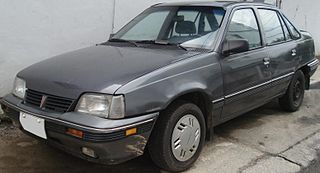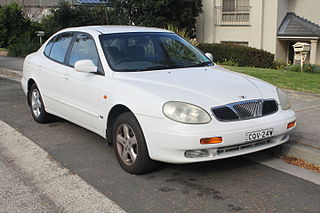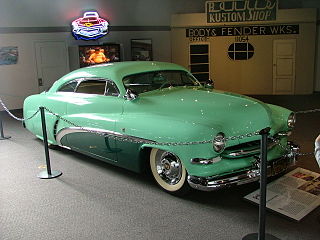
Lincoln Motor Company, or simply Lincoln, is the luxury vehicle division of American automobile manufacturer Ford. Marketed among the top luxury vehicle brands in the United States, Lincoln was positioned closely against its General Motors counterpart Cadillac. The division helped to establish the personal luxury car segment with the 1940 Lincoln Continental.

Mercury is a defunct division of the American automobile manufacturer Ford Motor Company. Created in 1938 by Edsel Ford, Mercury served as the medium-price brand of Ford for nearly its entire existence, bridging the price gap between the Ford and Lincoln model lines. Its principal competition was General Motors' Buick and Oldsmobile divisions, and Chrysler Motors' DeSoto and Chrysler brands.

GM Korea Company is the South Korean subsidiary of multinational corporation General Motors and the third largest automobile manufacturer in South Korea. GM Korea's roots go back to the former Daewoo Motors vehicle brand, which was split from its parent company, Daewoo Group, in 2002. In addition to importing vehicles for sale into South Korea, the company also operates three manufacturing facilities producing vehicles for the domestic market and for export. The company also operates GM Technical Center Korea, a design, engineering, research & development facility for various GM products, primarily small-size cars.

In the automotive industry, rebadging is a form of market segmentation used by automobile manufacturers around the world. To allow for product differentiation without designing or engineering a new model or brand, a manufacturer creates a distinct automobile by applying a new "badge" or trademark to an existing product line.

The Chevrolet Aveo (T200) is the first generation of the Chevrolet Aveo, a subcompact automobile nameplate from the Chevrolet division of the American manufacturer General Motors. The T200 was launched in 2002, developed by the initially-independent South Korean manufacturer Daewoo, later GM Korea. It was originally marketed as the Daewoo Kalos and prominently marketed with the Chevrolet brand as the Aveo. The model received the T200 internal codes during the car's development. The T250 code was designated for the model's major facelift.

Daewoo Motors was a South Korean automotive company established in 1937 as "National Motors". The company changed its name several times until 1982 when it became "Daewoo Motors" following its acquisition by the Daewoo Group. After running into financial difficulties, it sold most of its assets in 2002 to General Motors at $1.2 billion, becoming a subsidiary of the American company. In 2011, the name "Daewoo" was definitively removed with the company being renamed GM Korea and the Daewoo brand replaced by the Chevrolet marque.

The Acura Legend is a mid-size luxury/executive car manufactured by Honda from Japan. It was sold in the U.S. and Canada under Honda's luxury brand, Acura, from 1985 until 1995 as both a sedan, which was classified as a full-size car, and a coupe, which was classified as a mid-size car. It was the first flagship sedan sold under the Acura nameplate, until being renamed in 1996 as the Acura 3.5RL. The 3.5RL was the North American version of the KA9 series Honda Legend.

The Daewoo LeMans is a compact car, first manufactured by Daewoo in South Korea between 1986 and 1994, and between 1994 and 1997 as Daewoo Cielo — a car mechanically identical to the LeMans, differentiated only by its modified styling cues. Like all Daewoos preceding it, the LeMans took its underpinnings from a European Opel design. In the case of the LeMans, the GM T platform-based Opel Kadett E was the donor vehicle, essentially just badge engineered into the form of the LeMans, and later as the Cielo after a second more thorough facelift.

The Daewoo Leganza is an executive car (E-segment), sometimes classified as luxury large family car (D-segment), that was manufactured and marketed by the automobile manufacturer Daewoo. The Leganza was available as a front engine, front-wheel drive, four door, five passenger limousine in South Korea over a single generation for model years 1997-2002 and internally designated as the V100.

The Daewoo Espero is a four-door, five-seater mid-sized saloon produced by the South Korean company Daewoo Motors from September 1990 to 1997. The Espero was the first car entirely developed by Daewoo, which until then had only manufactured models developed by Opel. With the body designed by Bertone, the model is based on the platform of the Daewoo LeMans, a badge engineered version of the Opel Kadett manufactured in South Korea. The engines were supplied by Holden, with options ranging from the GM Family 1 1.5L to the GM Family II 2.0L. The Espero was replaced by the Daewoo Nubira in 1997, but continued to be produced until 1999 in Eastern Europe.

The SsangYong Chairman is a full-size luxury car that was manufactured by South Korean automaker SsangYong from 1997 to 2017. The original model was renamed Chairman H in 2008, with a new model introduced in the same year and designated Chairman W.

A custom car is a passenger vehicle that has been either substantially altered to improve its performance, often by altering or replacing the engine and transmission; made into a personal "styling" statement, using paintwork and aftermarket accessories to make the car look unlike any car as delivered from the factory; or some combination of both. A desire among some automotive enthusiasts in the United States is to push "styling and performance a step beyond the showroom floor - to truly craft an automobile of one's own." A custom car in British according to Collins English Dictionary is built to the buyer's own specifications.
The Continental Mark series is a series of personal luxury cars that was produced by Ford Motor Company. The nomenclature came into use with the Continental Mark II for 1956, which was a successor to the Lincoln Continental of 1939–1948. Following the discontinuation of the Mark II, Ford continued the use of the Mark series on Continental-branded vehicles from 1958 to 1960.

The Suzuki Carry is a kei truck produced by the Japanese automaker Suzuki. The microvan version was originally called the Carry van until 1982 when the passenger van versions were renamed as the Suzuki Every. In Japan, the Carry and Every are kei cars but the Suzuki Every Plus, the bigger version of Every, had a longer bonnet for safety purposes and a larger 1.3-liter 86-hp (63 kW) four-cylinder engine. They have been sold under myriad different names in several countries, including those with Chevrolet and Ford badges.

The F-segment is the 6th category and largest of the European segments for passenger cars, and always belongs to "luxury cars".
The Daewoo Royale is a series of mid-size cars that was produced by Daewoo in South Korea from 1983, being replaced by the Daewoo Prince in 1991, although production of the top-line Daewoo Imperial continued until 1993. The Royale's predecessor was launched in 1972 by General Motors Korea (GMK) as the Rekord, becoming the Saehan Rekord in 1976 when Saehan Motors replaced GMK, until production ended in 1978. This car was a version of the German Opel Rekord D.

A kei truck, kei-class truck, or Japanese mini truck is a mini truck, a type of pickup truck available in rear-wheel drive or four-wheel drive versions, built to satisfy the Japanese keijidōsha statutory class. They are known as keitora in Japan alongside the microvan.

The ninth generation of the Ford Thunderbird is a personal luxury coupe that was manufactured and marketed by Ford for the 1983 to 1988 model years. In response to the sales downturn of the 1980–1982 Thunderbird, the Thunderbird underwent an extensive model revision for the 1983 model year. While remaining a personal luxury coupe, the redesign of the Thunderbird marked a transition of the model range, emphasizing performance and handling over outright luxury and comfort content. As a central theme of the design, the ninth-generation Thunderbird marks the introduction of highly aerodynamic body design to Ford vehicles in North America, followed by similarly designed model lines, including the 1984 Ford Mustang SVO, 1984 Ford Tempo, 1986 Ford Aerostar, and 1986 Ford Taurus.

UzAuto Motors is an automotive manufacturer owned by the Government of Uzbekistan. It is based in Asaka, Uzbekistan. It manufactures vehicles under the marques Chevrolet and Ravon, which is Uzbek for calm and straight road or easy journey.

The automotive industry in South Korea is the fifth-largest in the world as measured by automobile unit production and also the sixth-largest by automobile export volume.




















